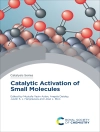Computational and theoretical tools for understanding biological processes at the molecular level is an exciting and innovative area of science. Using these methods to study the structure, dynamics and reactivity of biomacromolecules in solution, computational chemistry is becoming an essential tool, complementing the more traditional methods for structure and reactivity determination. Modelling Molecular Structure and Reactivity in Biological Systems covers three main areas in computational chemistry; structure (conformational and electronic), reactivity and design. Initial sections focus on the link between computational and spectroscopic methods in the investigation of electronic structure. The use of Free Energy calculations for the elucidation of reaction mechanisms in enzymatic systems is also discussed. Subsequent sections focus on drug design and the use of database methods to determine ADME (absorption, distribution, metabolism, excretion) properties. This book provides a complete reference on state of the art computational chemistry practised on biological systems. It is ideal for researchers in the field of computational chemistry interested in its application to biological systems.
Table of Content
Part One: Molecular Conformation and Electronic Structure of Biomolecules;
ELECTOWEAK QUANTUM CHEMISTRY AND THE DYNAMICS OF PARITY VIOLATION IN CHIRAL MOLECULES;
CHARACTERIZATION OF PROTEIN FOLDING/UNFOLDING AT ATOMIC RESOLUTION;
THE ROLE OF ATTRACTIVE FORCES ON THE DEWETTING OF LARGE HYDROPHOTIC SOLUTES;
STRUCTURE AND MECHANISM OF THE ATPASE VCP/P97: COMPUTATIONAL CHALLENGES FOR STRUCTURE DETERMINATION AT LOW RESOLUTION;
THEORETICAL ANALYSIS OF MECHANOCHEMICAL COUPLING IN THE BIOMOLECULAR MOTOR MYOSIN;
MOLECULAR DYNAMICS AND NEUTRON DIFFRACTION STUDIES OF THE STRUCTURING OF WATER BY CARBOHYDRATES AND OTHER SOLUTES;
Part Two: Chemical Reactivity in Biological Surroundings;
FROM PRION PROTEIN TO ANTICANCER DRUGS: QM/MM CAR-PARRINELLO SIMULATIONS OF BIOLOGICAL SYSTEMS WITH TRANSITION METAL IONS;
SIMULATIONS OF ENZYME REACTION MECHANISMS IN ACTIVE SITES: ACCOUNTING FOR AN ENVIRONMENT WHICH IS MUCH MORE THAN A SOLVENT PERTURBATION;
THEORETICAL STUDIES OF PHOTODYNAMIC DRUGS AND PHOTOTOXIC REACTIONS;
ACID/BASE PROPERTIES OF RADICALS INVOLVED IN ENZYME-MEDIATED 1, 2-MIGRATION REACTIONS;
DEVELOPMENT OF A HETEROGENEOUS DIELECTRIC GENERALIZED BORN MODEL FOR THE IMPLICIT MODELING OF MEMBRANE ENVIRONMENTS;
ASSESSMENT AND TUNING OF A POISSON BOLTZMANN PROGRAM THAT UTILIZES THE SPECIALIZED COMPUTER CHIP MD-GRAPE-2 AND ANALYSIS OF THE EFFECT OF COUNTER IONS;
INTRINSIC ISOTOPE EFFECTS- THE HOLY GRAAL OF STUDIES OF ENZYME-CATALYZED REACTIONS;
SUICIDE INACTIVATION IN THE COENZYME B12-DEPENDENT ENZYME DIOL DEHYDRATASE;
SIMULATIONS OF PHOSPORYL TRANSFER REACTONS USING MULTI-SCALE QUANTUM MODELS;
SELECTIVITY AND AFFINITY OF MATRIX METALLOPROTEINASE INHIBITORS;
INVESTIGATIONS OF CATALYTIC REACTION MECHANISMS OF BIOLOGICAL MACROMOLECULES BY USING FIRST PRINCIPLES AND COMBINED CLASSICAL MOLECULAR DYNAMICS METHODS;
Part Three: Toward Drug Discovery;
CHANGING PARADIGMS IN DRUG DISCOVERY;
A TALE OF TWO STATES: REACTIVITY OF CYTOCROME P450 ENZYMES;
THE ROLE AND LIMITATIONS OF COMPUTATIONAL CHEMISTRY IN DRUG DISCOVERY;
IMPROVING CATALYTIC ANTIBODIES BY MEANS OF COMPUTATIONAL TECHNIQUES;
THE ‘THEORETICAL’ CHEMISTRY OF ALZHEIMER’S DISEASE: THE RADICAL MODEL;
MECHANISTIC MODELING IN DRUG DISCOVERY: MMP-3 AND THE HERG CHANNEL AS EXAMPLES;
Subject Index












